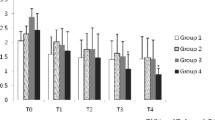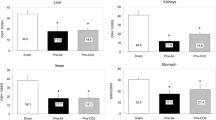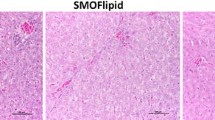Abstract
Background: Carbon dioxide is usually preferred as the insufflating agent for laparoscopic surgery because it is readily available, noncombustible, and chemically stable. It is still questionable, however, if CO2 pneumoperitoneum has any effect on free radicals and lipid peroxidation. The purpose of this study was to investigate the possible effects of CO2 pneumoperitoneum on free radicals and lipid peroxidation in the erythrocytes of rats.
Methods: Fifty male Sprague-Dawley rats were divided into five equal groups: controls, a sham-operation group, and three groups of 5, 10, or 15 mmHg pneumoperitoneum with CO2. At the end of the procedure, blood was collected and the erythrocytes were separated from the plasma. The resultant supernatant fractions of erythrocytes were assayed for superoxide dismutase (SOD), catalase (CAT), and malondialdehyde (MDA).
Results: SOD activities of the 5 and 10 mmHg pneumoperitoneum groups were significantly lower than those of the sham operation group. SOD activity was greater in the 15 mmHg pneumoperitoneum group than in any of the other groups, and this activity was significantly different from that seen in the 5 and 10 mmHg pneumoperitoneum groups (p < 0.05). No significant changes were observed in the CAT activities of the study groups (p > 0.05). MDA level was increased in the 5 mmHg pneumoperitoneum group; this result was statistically different from the control and 15 mmHg pneumoperitoneum groups (p < 0.05). No significant differences were found in the CAT activities for the study groups. On the other hand, the SOD activities of the 5 and 10 mmHg pneumoperitoneum groups were significantly lower than those of the sham and the 15 mmHg pneumoperitoneum group (p < 0.05 for all comparisons).
Conclusions: These results indicate that CO2 pneumoperitoneum applied with 5–10 mmHg pressure increases the formation of free oxygen radicals by inhibiting SOD activity and that the accumulation of free radicals elevates the level of MDA, a metabolite of lipid peroxidation. The effect of CO2 pneumoperitoneum on free radicals and lipid peroxidation is pressure-dependent in rats. The mechanism underlying this pressure dependency is still under investigation.
Similar content being viewed by others
Author information
Authors and Affiliations
Additional information
Received: 16 December 1999/Accepted: 14 February 2000/Online publication: 10 May 2000
Rights and permissions
About this article
Cite this article
Sare, M., Yilmaz, I., Hamamci, D. et al. The effect of carbon dioxide pneumoperitoneum on free radicals. Surg Endosc 14, 649–652 (2000). https://doi.org/10.1007/s004640000168
Published:
Issue Date:
DOI: https://doi.org/10.1007/s004640000168




